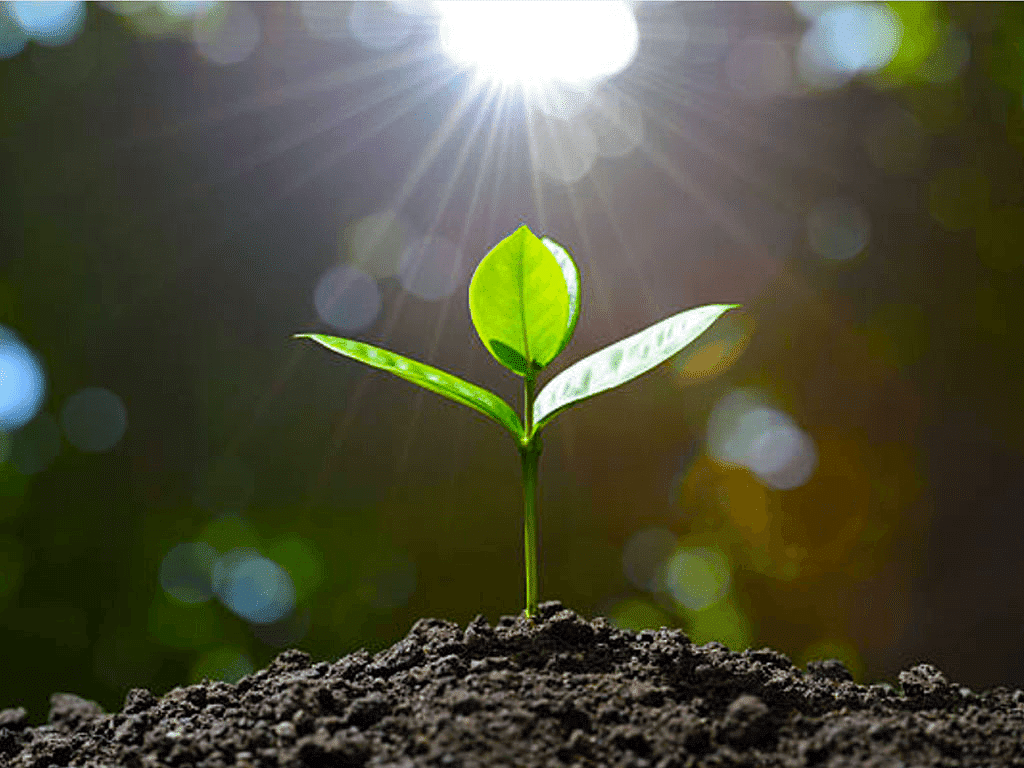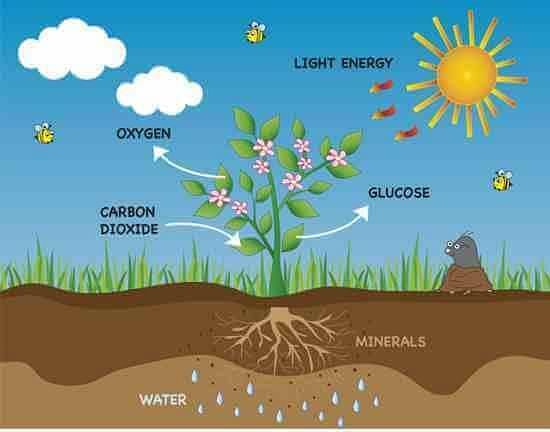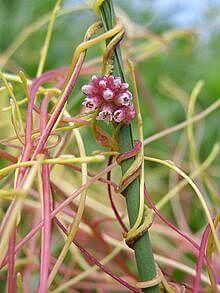Class 7 Exam > Class 7 Notes > Science Class 7 > Chapter Notes: Nutrition in Plants
Nutrition in Plants Class 7 Notes Science Chapter 1
| Table of contents |

|
| Introduction |

|
| Mode of Nutrition in Plants |

|
| Photosynthesis- Food-Making Process in Plants |

|
| Other Modes of Nutrition in Plants |

|
| Saprotrophs |

|
| How Nutrients are Replenished in the Soil |

|
Introduction
- Food is essential for all living organisms.
- Carbohydrates, proteins, fats, vitamins, and minerals are components of food.
- These components are known as nutrients and are vital for our bodies.
- All living organisms, including humans, require food.
 Nutrients in Plants
Nutrients in Plants
- Plants have the ability to produce their own food, while animals, including humans, cannot. They obtain food from plants or other animals that consume plants.
- Therefore, humans and animals are directly or indirectly reliant on plants for their food supply.
Mode of Nutrition in Plants
- Plants are unique organisms capable of producing their food using water, carbon dioxide, and minerals present in their environment.
- Nutrients obtained by plants are essential for building and repairing their bodies, as well as providing energy for life processes.
 Mode of Nutrition in Plants
Mode of Nutrition in Plants
- Nutrition refers to the process of acquiring and utilizing food by an organism.
- Autotrophic nutrition is when organisms create food from basic substances, hence plants are known as autotrophs.
- Animals and most other organisms are heterotrophs that consume food prepared by plants.
Photosynthesis- Food-Making Process in Plants
- Food production in plants is a crucial aspect. It is important to know if food is synthesized in all plant parts or specific regions.
- Plants acquire raw materials from their surroundings and transport them to their food factories.
- Photosynthesis is the process by which plants produce food, primarily occurring in their leaves.
- Raw materials required for photosynthesis include water and minerals absorbed by roots, and carbon dioxide taken in through leaf pores called stomata.
 Stomata
Stomata
- Transport vessels in plants carry water and minerals to the leaves, forming a continuous path for nutrient delivery.
- Chlorophyll, a green pigment in leaves, captures sunlight energy necessary for synthesizing food from carbon dioxide and water.
- Photosynthesis, reliant on sunlight, chlorophyll, carbon dioxide, and water, is crucial for producing food and oxygen essential for life on Earth.
- In the absence of photosynthesis, food production would cease, impacting the survival of most living organisms and making life on Earth impossible.
- During photosynthesis, chlorophyll-containing leaf cells use sunlight to convert carbon dioxide and water into carbohydrates, releasing oxygen as a byproduct.
 Chlorophyll
Chlorophyll
- The presence of starch in leaves indicates successful photosynthesis, as starch is a form of carbohydrate produced in the process.
- Living organisms' bodies consist of cells, similar to how buildings are constructed of bricks.
- Cells, the fundamental units of life, are visible only under a microscope.
- Some organisms are unicellular, composed of a single cell enclosed by a cell membrane.
- Most cells contain a centralized spherical structure known as the nucleus, surrounded by cytoplasm.
 Photosynthesis
Photosynthesis
Question for Chapter Notes: Nutrition in PlantsTry yourself: Which part of the plant absorbs water and minerals from the soil?View Solution
Synthesis of plant food components other than carbohydrates
- Plants create carbohydrates via photosynthesis using carbon, hydrogen, and oxygen.
- These carbohydrates are utilized to produce proteins and fats.
- Plants need nitrogen for synthesizing proteins, which are nitrogen-containing compounds.
- Nitrogen, abundant in the air in gaseous form, cannot be directly absorbed by plants.
- Special soil bacteria transform gaseous nitrogen into a usable form and release it into the soil for plant absorption.
- Farmers often apply nitrogen-rich fertilizers to the soil to meet plant nitrogen requirements.
- Once plants obtain nitrogen along with water, they can synthesize proteins and vitamins.
Other Modes of Nutrition in Plants
- Some plants lack chlorophyll and cannot make their own food.
- Plants like Cuscuta (Amarbel) are examples of such plants.
- Cuscuta is a parasite plant that takes food from the plant it climbs on, known as the host.

Cuscuta: A Parasite
- There are plants that can trap and digest insects for nutrients, known as insectivorous plants.
- Insectivorous plants have specialized structures like pitchers to trap insects.
- These plants digest the trapped insects and absorb their nutrients.
- Such plants may not obtain all necessary nutrients from the soil they grow in.
Saprotrophs
- Saprotrophs are organisms like fungi that obtain nutrients from dead and decaying matter through saprotrophic nutrition.
- Fungi, such as mushrooms, absorb nutrients from their surroundings, including bread, pickles, leather, and clothes left in hot and humid conditions.
 Saprotrophs
Saprotrophs
- Fungal spores, commonly present in the air, germinate on wet and warm surfaces, leading to growth and potential spoilage of items.
- Protection from fungal spoilage involves keeping items dry and cool to prevent spore germination.
- Symbiosis involves a mutually beneficial relationship between organisms, such as certain fungi living in plant roots and lichens composed of algae and fungi working together.
- In plant-fungus symbiosis, plants provide nutrients to fungi, while fungi offer water and specific nutrients in return.
- Lichens consist of a partnership between chlorophyll-containing algae and fungi where the algae produce food through photosynthesis, benefiting both partners.
How Nutrients are Replenished in the Soil
- Farmers spread manure or fertilisers in fields to replenish nutrients in the soil.
- Plants absorb minerals and nutrients from the soil, leading to a decline in soil nutrients over time.

- Fertilisers and manures contain essential nutrients like nitrogen, potassium, and phosphorous which need to be added periodically to enrich the soil.
- Crop plants, especially, absorb a significant amount of nitrogen, causing nitrogen deficiency in the soil.
- Plants require nitrogen in a soluble form, which is not readily available from the air.
- The bacterium Rhizobium converts atmospheric nitrogen into a usable form for plants, particularly legumes like gram, peas, and beans.
- Rhizobium forms a symbiotic relationship with these plants, exchanging nitrogen for food and shelter.
 Rhizobium Nodules
Rhizobium Nodules
- The association between Rhizobium and leguminous plants reduces the need for nitrogenous fertilisers, benefiting farmers.
- Most plants are autotrophs, while some are parasitic or saprotrophic, deriving nutrition from other organisms.
- Insectivorous plants can be considered partial heterotrophs, as they supplement their nutrition by consuming insects.
The document Nutrition in Plants Class 7 Notes Science Chapter 1 is a part of the Class 7 Course Science Class 7.
All you need of Class 7 at this link: Class 7
|
111 videos|246 docs|28 tests
|
FAQs on Nutrition in Plants Class 7 Notes Science Chapter 1
| 1. What is the main mode of nutrition in plants? |  |
Ans. The main mode of nutrition in plants is photosynthesis, where they make their own food using sunlight, water, and carbon dioxide.
| 2. What is photosynthesis and how does it work? |  |
Ans. Photosynthesis is the process by which plants use sunlight to convert water and carbon dioxide into glucose (sugar) and oxygen. This process takes place in the chloroplasts of plant cells.
| 3. What are saprotrophs and how do they obtain nutrients? |  |
Ans. Saprotrophs are organisms that obtain nutrients by decomposing dead organic matter. They secrete enzymes that break down the organic material into simpler substances, which they can then absorb as nutrients.
| 4. Apart from photosynthesis, are there any other modes of nutrition in plants? |  |
Ans. Yes, apart from photosynthesis, plants can also obtain nutrients through modes like parasitism, symbiosis, and carnivory.
| 5. How are nutrients replenished in the soil for plants to absorb? |  |
Ans. Nutrients are replenished in the soil through processes like decomposition of organic matter, weathering of rocks, and nitrogen fixation by certain bacteria. These nutrients are then absorbed by plant roots for growth and development.

|
Explore Courses for Class 7 exam
|

|
Signup for Free!
Signup to see your scores go up within 7 days! Learn & Practice with 1000+ FREE Notes, Videos & Tests.
Related Searches













